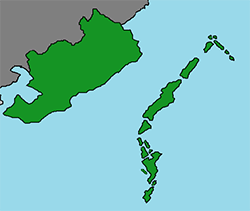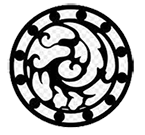Goga
Imperial Regality of Goga(고가황국[高佳皇國]) Goga(고가[高佳]) | |
|---|---|
| Motto: Grand and Beautiful!(고귀하고 아름답다!) | |
 Map of Goga | |
| Capital | Ando |
| Official languages | Gogan |
| Recognised national languages | Gogan |
| Recognised regional languages | Western Dialect, Eastern Dialect, Island Dialect |
| Ethnic groups (2021) | Gogan |
| Demonym(s) | Gogan |
| Government | Absolute Monarchy |
• Potentate(천제[天帝]) | Si Cheon(시천[始天]) |
• Regal Lady(천부인[天夫人]) | Ahee Buin(아희부인[娥喜夫人]) |
• Chancellor(재상[宰相]) | Eul Gang(을강[乙剛]) |
• Commandant(대장군[大將軍]) | Dae Inpa(대인파[大人破]) |
| Establishment | |
• Hwanguk(환국[桓國]) | 7197 B.C. |
• Goguk(고국[古國]) | 2333 B.C. |
• Goguk(고국[高國]) | 37 B.C. |
• Hayeoga(하여가[荷旅佳]) | 918 A.D. |
• Haega(해가[海佳]) | 1392 A.D. |
• Goga(고가[高佳]) | August 11, 2021 A.D. |
| Area | |
• Total | 621,000 km2 (240,000 sq mi) |
| Population | |
• 2021 estimate | 32,554,000 |
• Density | 52.42/km2 (135.8/sq mi) |
| GDP (nominal) | 2020 estimate |
• Per capita | 59,733 |
| Gini (2016) | 46.9 high |
| HDI (2016) | 0.91 very high |
| Currency | Zamastan ziapet/dollar |
| Date format | mm-dd-yyyy |
The Imperial Regality of Goga, commonly known as Goga, is a nation located in southeastern Ausiana. It is a member of the Coalition of Crown Albatross.
Etymology
The name of the nation, "Goga(고가)", means "Lofty and Beautiful". "Go(고)" means "Lofty" in Gogan language, and "Ga(가)" means "Beautiful". The name comes from the idea of Si Cheon, the inaugural Emperor of the nation, who thought the beautiful cliffs, coasts, and the sea of its territory are lofty and beautiful in sight.
History
The history of Goga can be traced back to Prehistoric times, when fractured artefacts, such as jade and wooden rings, have been spotted near the southern coasts of Gogan mainland. Gogan scholars date the srtefacts back to 4.5 million years ago; however, the actual date is under speculation, as the claimed dates are in dispute amongst the Gogan archaeologists.
Near the Northern borders of the Gogan mainland, dolmen and what are suspected to be sharp, wooden swords have been spotted and are found to be dated nearly 10,000 years ago. It is suspected that burials and agriculture have started during that period. However, hunting and fishing were mostly prevalent, and it is suspected that people of the era lived in makeshift houses and caves. In 7,197 B.C., Bronze Age has begun, when ethnic Gogans began making bronze accessories and weapons to proclaim territories and make permanent dwellings with thatches. Thatched houses with holes in the middle of the inside of the house for fire were common around then. As people claimed territories, a new nation called, "Hwan", or "Hwanguk", which means "Hwan nation", has been founded, and social classes with hierarchy started to form with the kings, proclaimed as sons of the gods and nature, at the top and ordinary men and women at the bottom of the social ladder. It is unclear what the general term of kings in Hwan were; however, the first king of Hwan was Anpagyeon, who ruled from 7,197 B.C. for an unknown period of time. At that time, people had long life spans, as IEarth had not been exposed to ultraviolet rays due to natural depletion of ozone layer, where people lived for hundreds of years without frailty. Therefore, each king ruled for a few hundred years, although it is unknown even to this day how many rulers have ruled over Hwanguk. The last king of Hwan was Hwanin, and he did not have children for a long time, so he prayed to the gods for offspring. It is, by tale, Hwanung has been granted to him from the god of the Sky. Although, Hwanin most likely impregnated a Hwan woman to get the child. At that time, the capital city of Hwan, as speculated, was in the northeastern area of the current Gogan mainland. Hwanung with 3,000 men moved the capital to the southwestern end of the current Gogan mainland. As he was travelling there, he met a tribe that worships bears and a tribe that worships tigers. Both wanted to become loyal to Hwanung. It is, by tale, Hwanung tested the two tribes by having them eat garlic and limpwurt for three weeks, and the tribe that endures the ordeal would follow Hwanung to his new capital. The tribe that worships tigers gave up after ten days, and the tribe that worships bears ate garlic and limpwurt for three weeks, and the daughter of the leader of the bear tribe was wedded to Hwanung and gave birth to a child named, "Dangun Wanggeom". Dangun Wanggeom would form a new nation called, "Goguk", in the new capital city in 2333 B.C.
Dangun Wanggeom named the capital city, "Sinsi", and created a set of rules for his citizens to abide by. The set of rules is called, "The Eight Articles of Bumgeom", which specifically state people of Goguk are allowed to possess slaves and to refrain from theft, lest they pay eightfold of the amount they have stolen. During the era of Goguk, enhanced bronze weaponry has been formed, such as the Bipa bronze sword and Sehyeong bronze sword, which had been known to be extremely sharp and light at the same time. For upper classes, burial spots, such as dolmens, were made to commemorate the dead. In 237 B.C., King Jun of Goguk engaged in extravagance and treated his citizens with contempt and neglect. As a result, the Buyeo region of Goguk, led by Chumo, revolted against the Goguk royal family and overthrew King Jun. Chumo, then, in 37 B.C., formed a new nation called, "Goguk", which has a different meaning from the previous nation name, meaning, "lofty nation", as opposed to, "ancient nation", for the latter.

